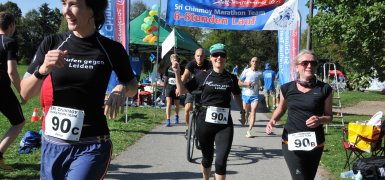Sass di Stria, Torres di Falzarego...
Sri Chinmoy gave the last concert in Torino on 30th May. We spent the night in the camp in the town and early in the morning we departed towards Cortina d’Ampezzo (via Venice and Belluno). Driving through highways all the way from Skopje we saw only plain fields and roads but when we started driving from Belluno towards Cortina the mountains started to show up and I started getting excited about the climbs getting so close. It was very satisfying finally driving through the scenic mountain roads and villages of Northern Italy and seeing the big walls of the mountains and towers rising out of nowhere.
- Cortina d'Ampezzo and the surrounding mountains
The period end of May / start of June is what is called “early” season in the Dolomites for climbing. The South sides of the mountains were clean of snow (as were all our chosen routes) but on the northern slopes there was still some snow to be found – especially in the steep and narrow gullies where we were supposed to pass on our way down. It was also off-season in the town of Cortina d’Ampezzo. When we arrived, the town was empty with only few people on the streets, many shops were closed due to “holidays” (for a month) and out of five camps only 2 were open. We settled down in the Cortina Camping and decided that next
day we would start our climbing.
31 May
Few routes had a start from the Falzarego Pass that is about 15km away from the town. This mountain pass is on 2117m height and we drove on the curved road from Cortina with a doubtful feeling about the weather since it was cloudy and grayish. As we arrived on the pass and looked towards Sass di Stria, the route we wanted to climb that day, we saw its top covered in clouds. Deciding to climb it anyway, we parked the car on the road towards Valparolla Pass where there is a small parking place “marked” with a big boulder on the left side. From here, there is a path that leads to the route that passes under the wall of the mountain and we came at the start in about 20 minutes. The start was marked with a driven in piton on the right side of the rib and putting the guidebook in my upper pocket of the backpack, after a moment of silence and concentration I headed up. The South Rib was first climbed by the Cobertaldo/Pezzoti party on 1 August 1939. It is an easy IV+ route (see Rating Systems) that follows the right side of the rib with occasional turns on right (passing under harder, overhang-like problems) and one rightwards traverse on the last pitch over a big ledge that got us under the crux of the route – a IV+ crack that leads to the top. It was a good introduction route for the Dolomites. We used it to check out if the gradings in the guidebook are as same as or close to the gradings that we climb on our local crags and to feel the rock. In the first two pitches I felt the rock a little slippery but we got used to it very fast and what satisfied us as far as we have climbed on limestone this rock was very solid and firm. We liked it a lot. When we got on the top we had a very nice look towards the surrounding valleys and mountains and also we could see the Falzarego Torres that we wanted to do next.
-Sass di Stria and Vesna on top
1 June
This day we wanted to do 2 routes on the Two Torres di Falzarego that are c.2500m high. The route that we wanted to climb on Torre Piccola di Falzarego was on the South Arête, first climbed by Comici/del Torso/Varale party on 10 August 1934. It was graded IV+ and it had 7 pitches. The route on Torre Grande di Falzarego was on the West Face and was first climbed by S. Lussato on 13 August 1957. It was graded IV and it had 4 pitches. We wanted to do these routes in one day since when abseiling down from Torre Piccola we would come into the gap between the two towers and after short scramble in the gully we would be directly at the start of the other route. We parked the car about 1km before Falzarego Pass driving from Cortina at the parking of a restaurant and after a walk of about an hour we were at the start of the Piccola route. When I was ready to start I had a quick look at the watch that I had in the pocket of my backpack and it said 10:30. The route starts on a ledge about 10 meters to the right from the arête and after 2 pitches of IV/IV+ joins the arête. It was written that it starts under a painted number “10” – I could only see the painted number about 10 meters up from the ledge and it was only when I looked up the face standing at the foot of the chimney that is located at the far left side of this ledge that I saw it… Anyway, at the harder pitches there was enough in – situ protection and only the first 3 pitches were “the harder ones”. I would like to say that even when someone says that there is enough protection on some Dolomite route, you should always bring some slings and nuts because if you are not used to climb with in-situ protection on bigger distances you may find it “tricky”. After that it was easy climbing on grade III+ and we came to the top. There we saw few cemented belay bolts but the actual abseil station was located on a path few meters from the top when we looked down towards Torre Grande. From there we made a 25m abseil that brought us on a terrace from where we were supposed to go into the gap between the Torres… As we sorted out the gear in the backpacks, I looked at the watch and it said 15:30… 5 hours?!?! I could not believe my eyes. I told Vesna about this and we sat in silence for a while. We climbed the route without having almost any problem of route finding and it was all somehow much faster… We decided to go down.
- Falzarego Pass and the two Torres di Falzarego
When we came to the car there was one Italian climber (we climbed with him when he visited Macedonia) with a friend who said that he was surprised seeing us down instead of climbing another route since it was only 13:30. Now I could not believe my ears; I checked my watch and it said 16:30. After getting into the car I realized this watch had two timers (during the climb I probably unknowingly pressed the button for the timer to change…), and because I hardly ever used the two timers I completely forgot about them - and to make things worse, we could have easily climbed the other route also… Our friends climbed Sass di Stria that afternoon and Vesna and I went to find the start of a route that we wanted to do on Picolla Lagazuoi. We went that night for pizza and decided that we would have another try tomorrow – with Vesna I would go on Torre Grande and our friends would repeat the route that we did today. We showed them the description, told them all they needed to know and the next day we split half way on the approach route and headed towards Torre Grande. We saw where this route started the day before, so it was an easy start and easy climbing. The crux slabs were blackened with water, which made them slippery, but it was not a big problem since the route was short and this was only for about few meters. After an easy scramble of II/III at the last pitch we were on the top and we sat
relaxed for a while.
2 June
We cast our eyes towards Lagazuoi, since we wanted to do a route there and also towards Tofana di Rozes. We wanted to do 2 routes on this big mountain also but the conditions there were still bad. The exit route was still much under snow and a few friends who were hiking there the day before told us said a big avalanche came off passing very close to them. The south face during the days while we were there was always covered with clouds and we could not see as much as half of the wall. Coming down from Torre Grande was tricky. We put all our equipment in our backpacks since in the guidebook it was written that we have to “descent a short, chossy gully to a notch…from there less distinct path”… We thought this means an easy scramble down, but the gully was very exposed with walls going way down from each side and it was tricky climbing down through a very broken terrain. There were cemented rings, which we could use for abseil or mid-belay points coming down roped together but we didn’t want to take off the equipment from the backpacks so we moved very slowly and it was OK… On the way down we met with the two friends of ours – they came out mid way of the Piccola route since there were few parties climbing slowly in front of them. At Torre Piccola just when you will pass the first 3 pitches there is a ledge from where you can descend to a path that will get you on the approach route…So this was the third route that we did and for the next day we planned to do a route on Piccola Lagazuoi with which we would make a climb on all the mountains that are around Falzarego offered in the guidebook. We were having nice climbing but we were not very happy about the weather since every afternoon the sky would get covered with clouds and we couldn’t make a brave decision to climb something much longer the next day not knowing how the weather would go. Each morning when we would see that the sky had not so many clouds, we would go and climb this short routes but later in the day the weather would change (while climbing we could see how the clouds were coming over from the west) and it was raining almost every afternoon or night. But we decided to climb the 250m high wall of the Piccolo Lagazuoi anyway since it was not that big and the route was fairly easy, at least in the
guidebook description...
- Sass di Stria (far right) and Cinque Torri (the "boulder" in the middle)



